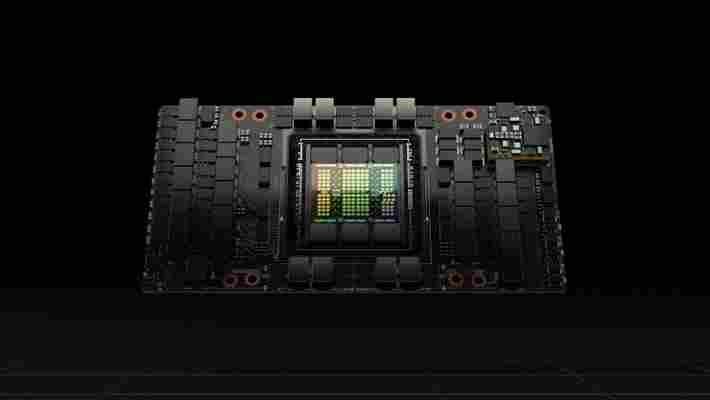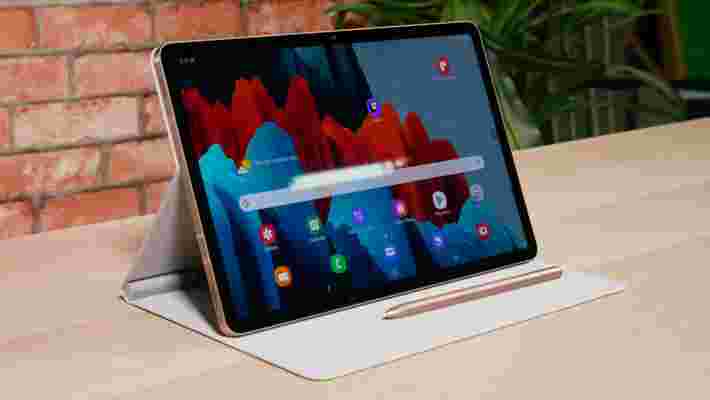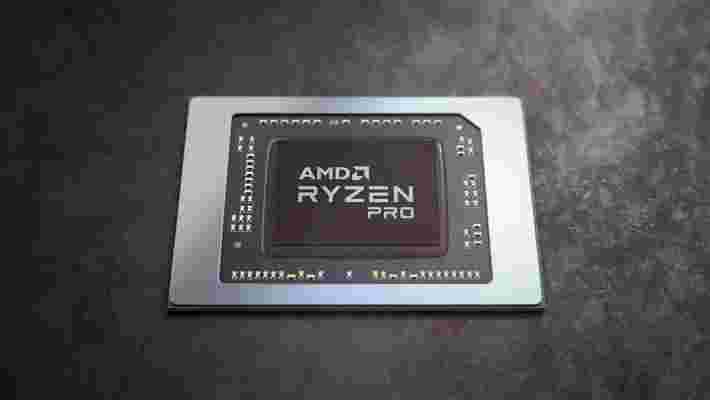Nvidia has unveiled its new Grace CPU Superchip designed for AI infrastructure and high performance computing at GTC 2022 .
The new 144-core Arm Neoverse -based discrete data center CPU is actually comprised of two CPU chips connected over the company's high-speed, low-latency, chip-to-chip (C2C) interconnect, NVLink .
Nvidia's Grace CPU Superchip complements its Grace Hopper Superchip which was announced last year and features one CPU and one GPU, on one carrier board. While their makeup may be different, both superchips share the same underlying CPU architecture as well as NVLink-CNC interconnect.
Founder and CEO of Nvidia, Jensen Huang explained in a press release how the Grace CPU Superchip is ideal for AI workloads, saying:
“A new type of data center has emerged — AI factories that process and refine mountains of data to produce intelligence. The Grace CPU Superchip offers the highest performance, memory bandwidth and NVIDIA software platforms in one chip and will shine as the CPU of the world’s AI infrastructure.”

Nvidia H100 and DGX H100
In an effort to power the next wave of AI data centers, Nvidia also announced its next-generation accelerated computing platform with Nvidia Hoppper architecture which succeeds the company's Nvidia Ampere architecture that launched two years ago.
The chipmaker even announced its first Hopper-based GPU which is packed with 80bn transistors. The Nvidia H100 is the world's largest and most powerful accelerator to date and like the Grace CPU Superchip, it also features NVLink interconnect for advancing gigantic AI language models, deep recommender systems, genomics and complex digital twins.
For enterprise businesses that want even more power, Nvidia's DGX H100 (its fourth-generation DGX system) features eight H100 GPUs and can deliver 32 petaflops of AI performance at new FP8 precision. This provides the scale to meet the massive compute requirements of large language models, recommender systems, healthcare research and climate science. It's worth noting that all of the GPUs in Nvidia's DGX H100 systems are connected by NVLink to provide 900GB/s connectivity.
The company's new Hopper architecture has already received broad industry support from leading cloud computing providers and Alibaba Cloud, AWS, Baidu AI Cloud, Google Cloud, Microsoft Azure, Oracle Cloud and Tencent Cloud all plan to offer H100-based instances. At the same time, Cisco, Dell Technologies, HPE, Inspur, Lenovo and other system manufacturers are planning to release servers with H100 accelerators.
Nvidia's H100 GPU is expected to be available worldwide later this year from cloud service providers, computer makers and directly from the company itself.
Samsung Galaxy Tab S8 marketing materials and price leak reveal almost everything
Hot on the heels of a massive Samsung Galaxy S22 leak , there’s now a similar one for the Samsung Galaxy Tab S8 range, including detailed marketing materials for all three upcoming slates.
This leak comes from the same source too, namely Evan Blass , who has an excellent track record for this stuff. As with the Samsung Galaxy S22 though, while this leak is extensive it doesn’t tell us much that we hadn’t already heard, as the Galaxy Tab S8 and its siblings have already been extensively leaked.
According to this latest leak, the Tab S8 has an 11-inch 1600 x 2560 LCD screen, an 8,000mAh battery, dimensions of 253.8 x 165.3 x 6.3mm, and a weight of 503g. The Samsung Galaxy Tab S8 Plus meanwhile is said to have a 12.4-inch 1752 x 2800 AMOLED screen, a 10,090mAh battery, dimensions of 285 x 185 x 5.7mm, and a weight of 572g.
Then there’s the Samsung Galaxy Tab S8 Ultra, which apparently has a 14.6-inch 1848 x 2960 AMOLED screen, an 11,200mAh battery, dimensions of 326.4 x 208.6 x 6.3mm, and a weight of 728g. All three tablets are also listed as having a 120Hz refresh rate, a Snapdragon 8 Gen 1 chipset, 45W charging, expandable storage, and an S Pen stylus in the box.
While we’d take these claims with a pinch of salt, given how reputable the source is and how convincing the materials look, we’re almost certain that this is all accurate.
That’s not the only Samsung Galaxy Tab S8 leak either, as Roland Quandt (another great leaker) has revealed what’s apparently the official prices in euros.
This puts the starting price of the standard Tab S8 at €749 (around $845 / £625 / AU$1,185), with the Samsung Galaxy Tab S8 Plus starting at €949 (roughly $1,070 / £790 / AU$1,500), and the Galaxy Tab S8 Ultra starting at €1,149 (approximately $1,300 / £960 / AU$1,820).
That’s with 128GB of storage and 8GB of RAM in each case, but there are other configurations with more memory and with 5G, which increase the price, as you can see above. We won’t break all of these down though as conversions are never entirely accurate anyway.
Spec details were also included here, and they both match the above and other recent leaks, so this is all looking highly likely.

Analysis: only the Samsung Galaxy Tab S8 Ultra looks truly new
Based on what we’ve heard so far (which is basically everything), the Samsung Galaxy Tab S8 and Samsung Galaxy Tab S8 Plus sound remarkably similar to their predecessors.
Sure, they have new chipsets, but their screens, battery size and charging speeds are all the same, and it’s not like the Samsung Galaxy Tab S7 range is lacking in power anyway. So upgrading might not actually feel like much of an upgrade.
The Samsung Galaxy Tab S8 Ultra, though, has no predecessor, and with a bigger screen and battery than any of Samsung’s current slates, it could be an appealing buy, particularly for anyone who wants something like an iPad Pro but not made by Apple.
The latest security is built into the latest hardware with AMD Ryzen PRO mobile processors
Businesses have enough on their plates. Digital security threats shouldn’t have to be a constant worry, and keeping systems protected against ever-shifting threats need not be a monumental effort for IT departments. The latest AMD PRO security integrated into AMD Ryzen™ PRO mobile processors simplifies and strengthens security with top-to-bottom protection that covers the hardware, OS, and OEM system levels.
AMD Ryzen™ PRO mobile processors are built with the Microsoft Pluton security processor integrated right onto the chip, making them the first x86 processors on the market to offer this technology. With the Pluton Security Processor, the system receives chip-to-cloud security for users’ data, applications, and identities.
The Microsoft Pluton security processor also makes it easier to keep systems safe over time. Straightforward Windows updates provide Pluton-enabled systems with the latest hardware and firmware protection. Working together with the other security technologies of AMD Ryzen™ PRO 6000 Series Mobile Processors, the two provide a unified front for robust security against attacks.

These new AMD chips support Microsoft Secured-core PC as well, helping ensure that systems are protected from firmware and OS attacks right from boot up by preventing unauthorized access to data and devices. Back that up with AMD Secure Processor on the chips and AMD Platform Secure Boot, which can create a hardware root-of-trust between the BIOS and OS bootloader, and you’ve got a strong layer of protection across the hardware in your system.
AMD Shadow Stack and Microsoft Stack Protection can work together to keep control-flow attacks shut down. Shadow Stack keeps a copy of the program stack stored on the system hardware to check against normal program stack.
Together, these technologies will leave little room for attackers to get into your systems and pull out sensitive data or gain control.
But, AMD is prepared for even more sophisticated attacks. AMD Ryzen™ PRO mobile processors can even actively encrypt system memory with AMD Memory Guard. So, even if someone could get access to your computer and attempt to read the data on the laptop’s memory modules, all they’d get back is encrypted data. This data is encrypted in real-time, too, so you can rest assured that at any moment the data on the memory would be unreadable to anyone without the key.
With the new AMD Ryzen™ Pro 6000 Series Mobile Processors, your business can enjoy all the enhanced performance capabilities of the latest AMD architecture technology. Plus, with the efficiency of the 6nm process node alongside the superb security technologies AMD has built into the hardware, each system can support further protection from OEMs.
You can find out even more about AMD PRO Security features here .